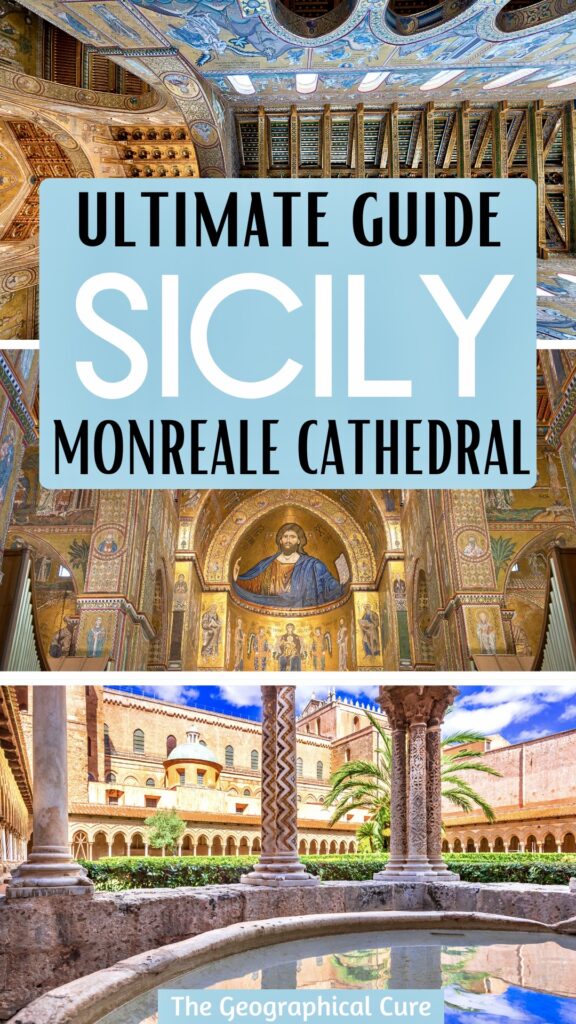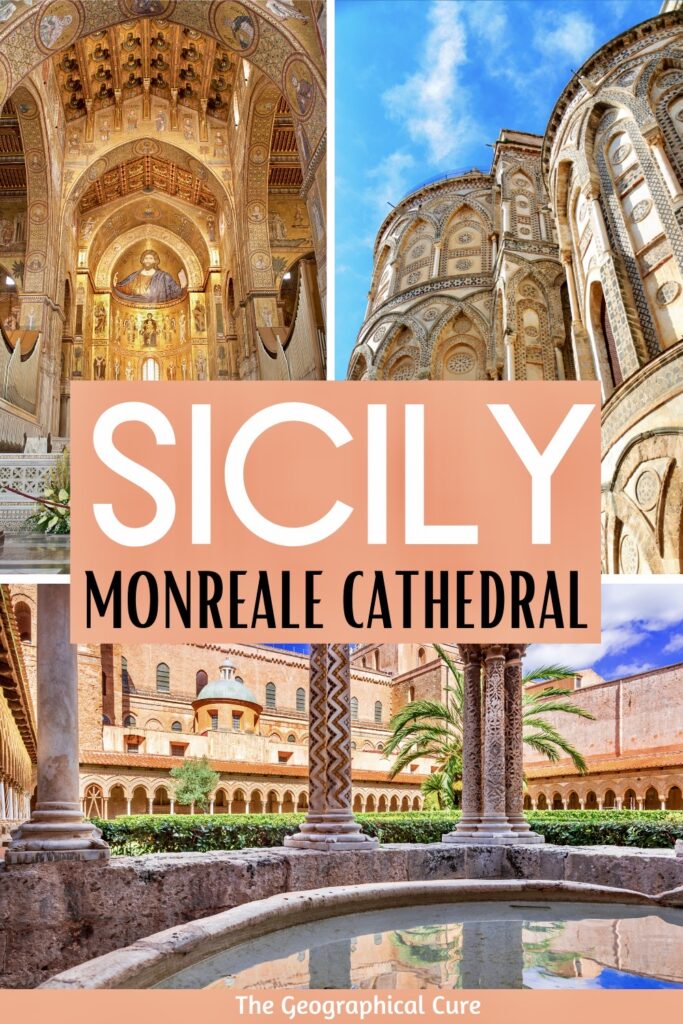Monreale Cathedral is the world’s most famous Norman cathedral and Sicily’s most beautiful church. It’s a jaw dropping architectural marvel slathered from floor to ceiling with glittering Byzantine mosaics. It reflects the glory of the Middle Ages.
Built between 1174-89, a young William II founded the cathedral to show off his power. He dedicated Monreale to the Virgin Mary. Legend holds that she came to him in a vision telling him where to find hidden treasure to finance the cathedral.
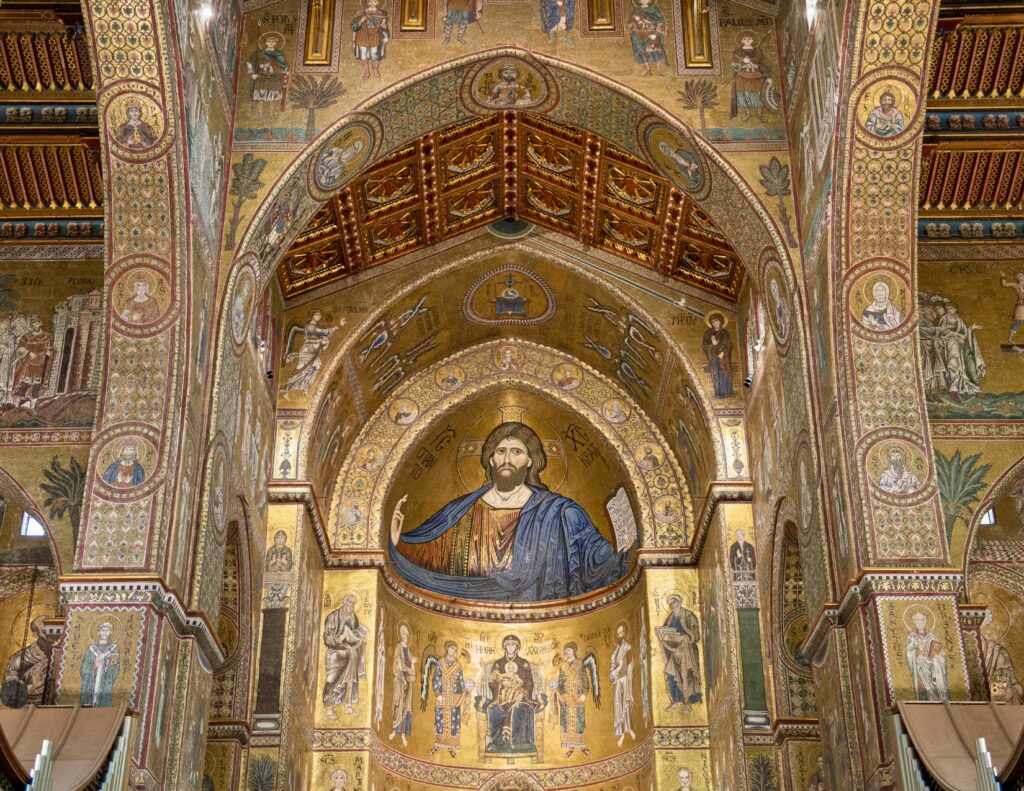
The cathedral is a “lasagna of history,” reflecting Sicily’s turbulent past and dizzying succession of conquering kingdoms.
History of Monreale Cathedral
Why did William build an enormous cathedral so close to the one in Palermo? It was a political, as well as an artistic, statement. William wanted to assert his royal authority and and cement a bond between the crown and the pope.
The Bishop of Palermo was William’s great rival. He was not under the crown’s jurisdiction and asserted autonomous authority under the Canons of Palermo Cathedral.
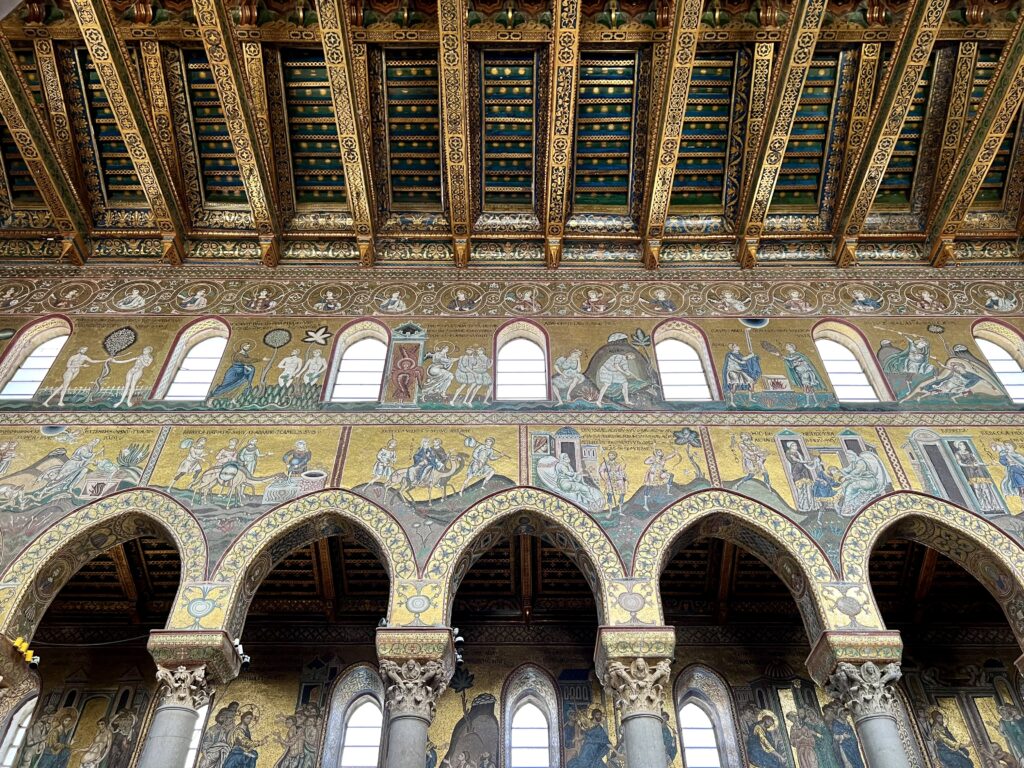
But the smug bishop crossed a line when he refused to honor William I’s wish to be buried at Cefalu Cathedral, instead burying him at Palermo Cathedral.
William II didn’t like that power grab one bit. He fought back. William decided to create a new bishopric and extend his territory.
Hiring artisans from all over Christendom, he built a cathedral designed to impress (and outdo Palermo Cathedral and Cefalu Cathedral). He also transferred the privilege of housing the royal tombs to Monreale, creating his own royal pantheon.
By William II’s death, the bulk of construction and decoration was complete. What survives today is pristine, almost completely as the king saw it in his day.
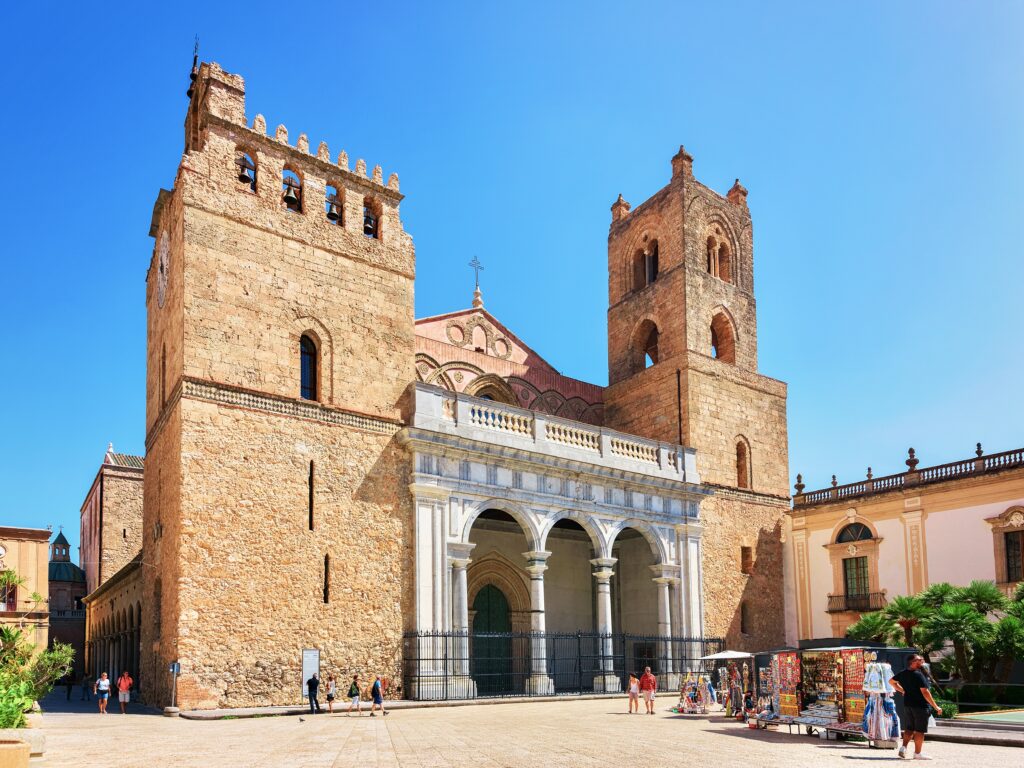
In 2015, William’s cathedral became a UNESCO site.
Guide To Monreale Cathedral: What To See
Here are the must see highlights when visiting Monreale Cathedral.
Facade
The fortress-like facade is not terribly remarkable and gives no hint of the wonders inside. Two square corner towers flank a great marble portal. It’s a Romanesque-type building with Arab, Norman, and Byzantine elements.
The present day portal dates from 1770. It was added to protect the bronze doors. It’s a rather stark contrast to the medieval front.
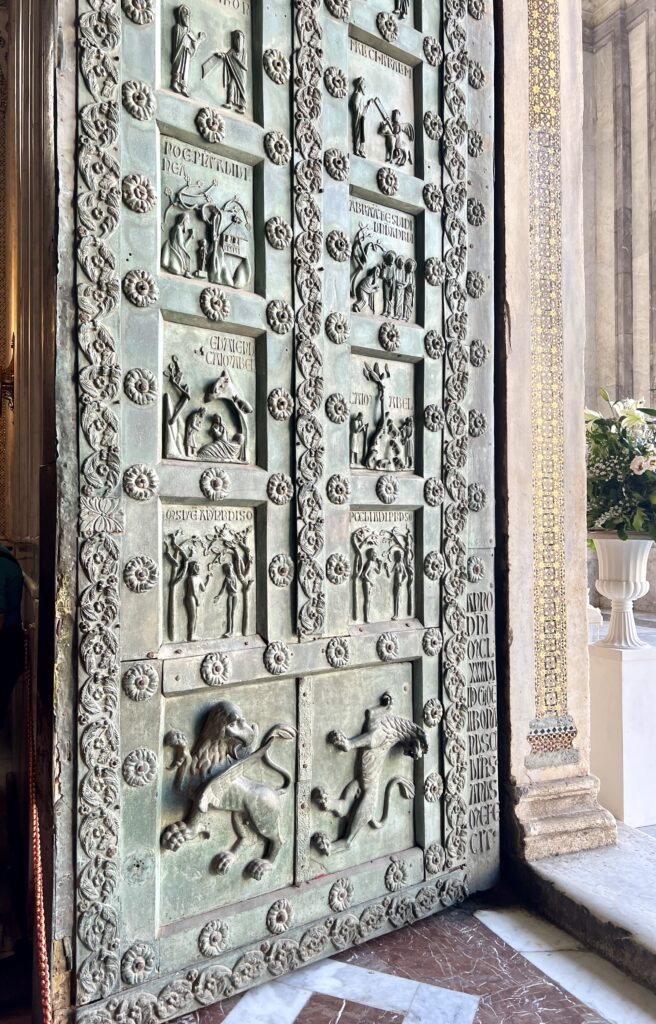
The bronze doors are dubbed the “Gates to Paradise” and were competed by Bonanno da Pisa, the architect of the Leaning Tower of Pisa. Fortunately, he was a better sculptor than architect.
The doors are decorated with 46 panels depicting episodes from the Old and New Testaments.
They’re rarely open. But the day I was there they were since a wedding was being held in the cathedral.
Be sure to walk around to see the rear facade. It’s a reminder that Arabs once ruled Sicily. You can see a profusion of Moorish decorations — repeating ogival arches and geometric medallions made with black lava, limestone, and marble inlays.
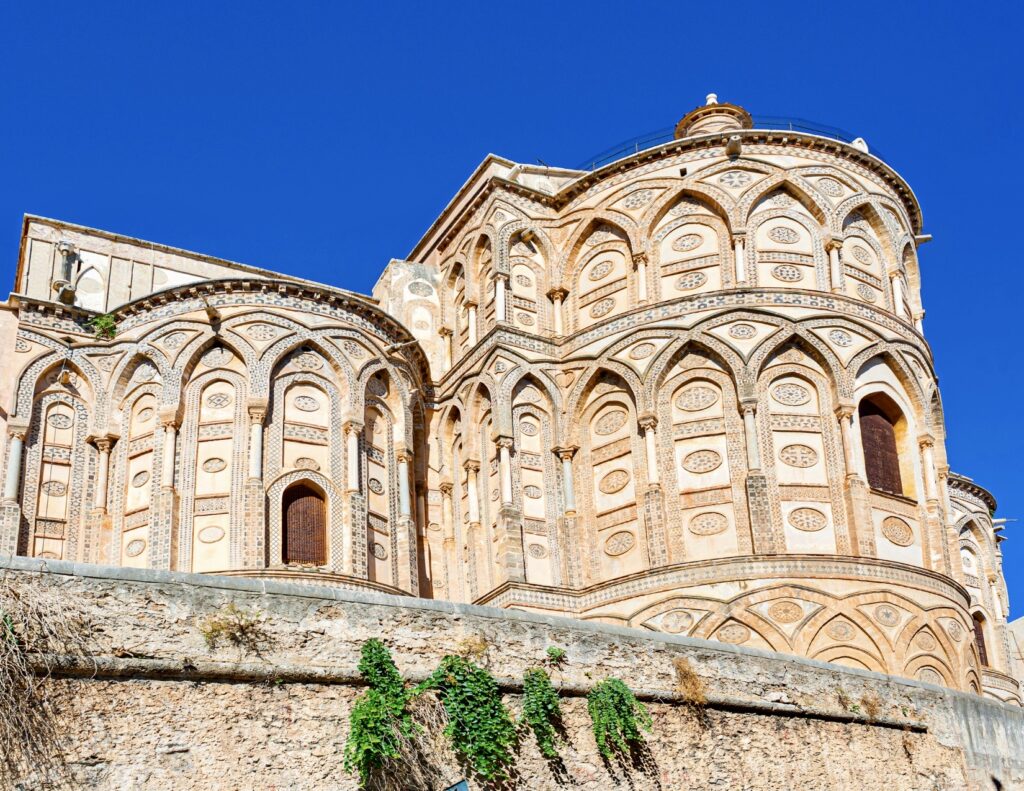
Interior
The cathedral design was typical of religious architecture of the 12th century. It had a central Byzantine style plan with a Greek cross and two side aisles. The nave is almost 400 feet long. In the east, there are three monumental apses.
It’s almost shocking in scale. You’ll also be dazzled by the Byzantine-style floors, Corinthian columns, and intricate carved wood ceiling.
The marble floors date from the 12th century, with only a few restorations in 1560. The central aisle is composed of Old Testament scenes, and the side aisles show the miracles of Jesus.
The marble was likely recycled from ancient buildings. The prettiest bits have red porphyry and green marble disks surrounded by geometric stars.
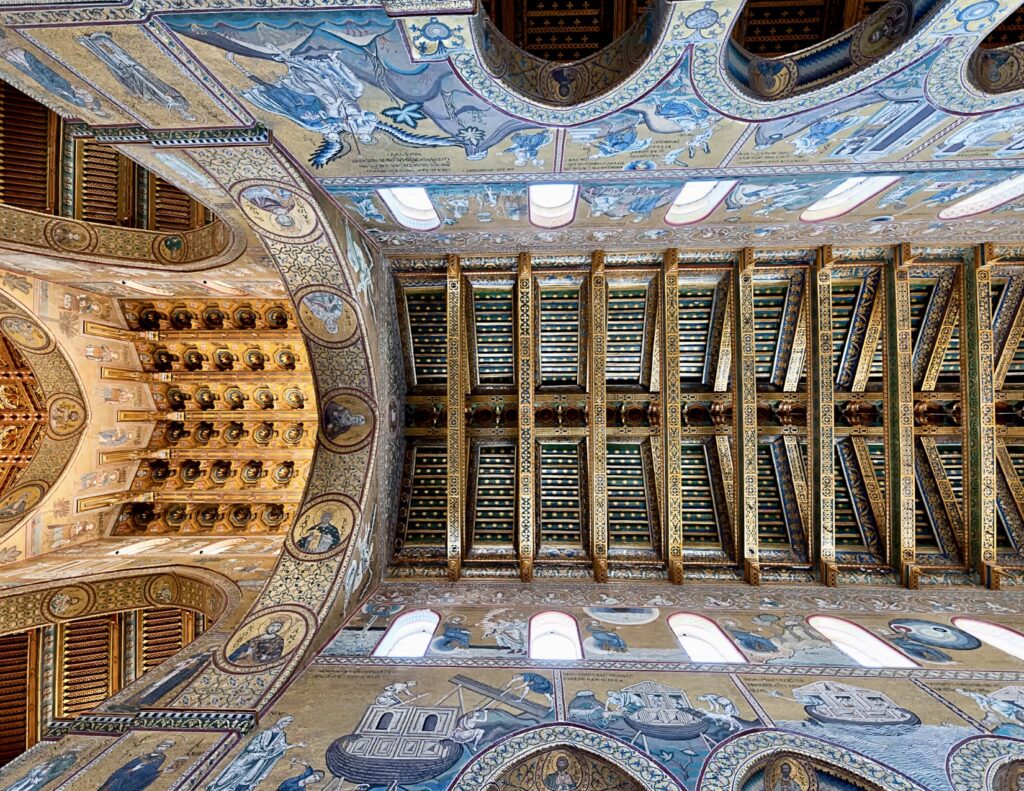
The ceiling above is not original, having been hit by lightning and destroyed in 1811. But it has pretty gilded and painted trusses that are a replica of the original.
The nave and the aisle are divided by 18 tall Corinthian columns, 9 on each side.
Pope Lucius III gifted William II the columns and figured capitals, hoping to cement Sicily’s loyalty to the Vatican. They were likely taken from a Roman temple and shipped all the way from Rome.
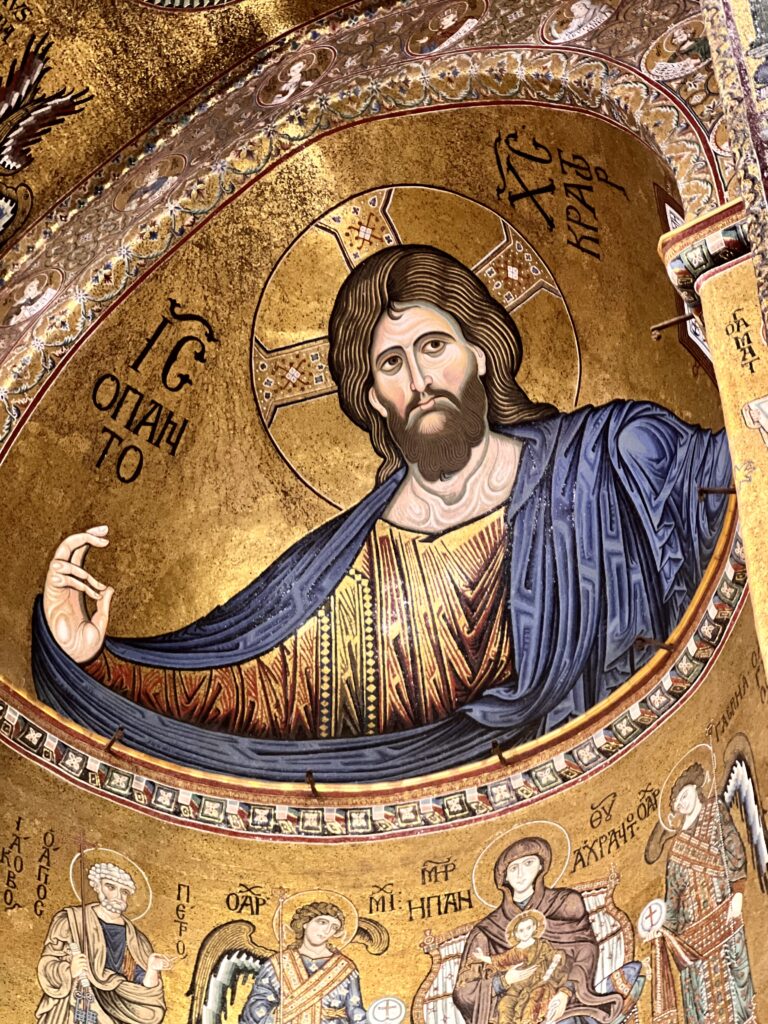
Mosaics
Monreale’s interior is famous for its well-preserved 12th century mosaics, which cover almost every wall. This rich figural decoration is what makes Monreale Cathedral a historic treasure of the first order. The beauty cannot be overstated.
The mosaics came from Sicily and Venice. But they are of Byzantine style. They celebrate both the Christian faith and the Norman rulers.
In total, there are 68,000 square feet of mosaics. It was astonishing to me that they were completed in just 10 years.
The gold background effect is achieved by putting tiny pieces of gold leaf between glass. This also helps reflect light.
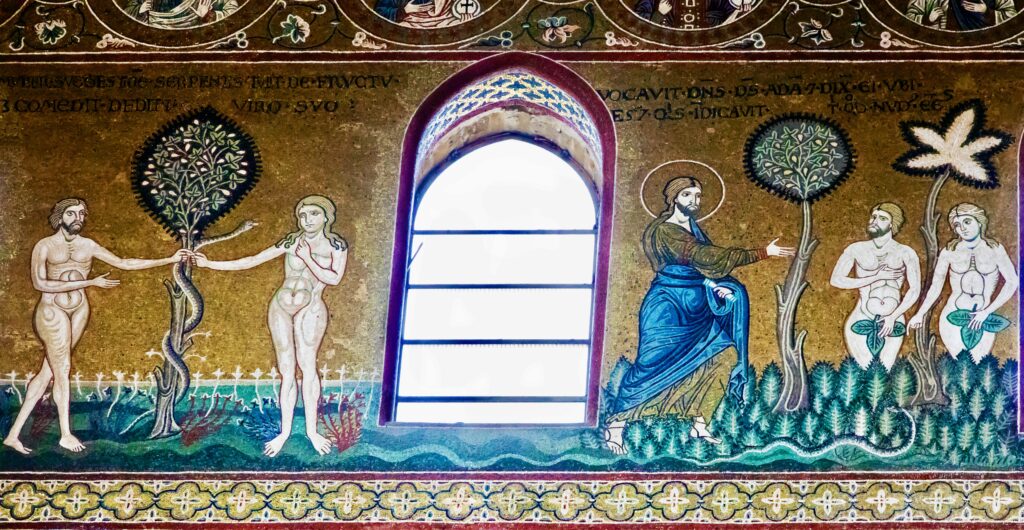
The mosaics depict a host of episodes and an endless cast of characters from the story of Genesis, from the creation to the assumption. The mosaics are realistic and expressive, with a poetic unity.
You begin “reading” the mosaics in the nave on the south wall of the central aisle. Start at the left end, with the upper row of pictures, and move clockwise.
The highlight, in the vault of the central apse, is a huge mosaic of Christ Pantocrater glowing like the sun.
At 60 feet tall, it’s the largest pantocrater in Europe. It depicts a long-haired Christ in glory raising his right hand in a two fingered Byzantine-style blessing.
Though he looks rather sad, his outstretched arms seem like an embrace. Just the blessing hand is 6 feet tall.
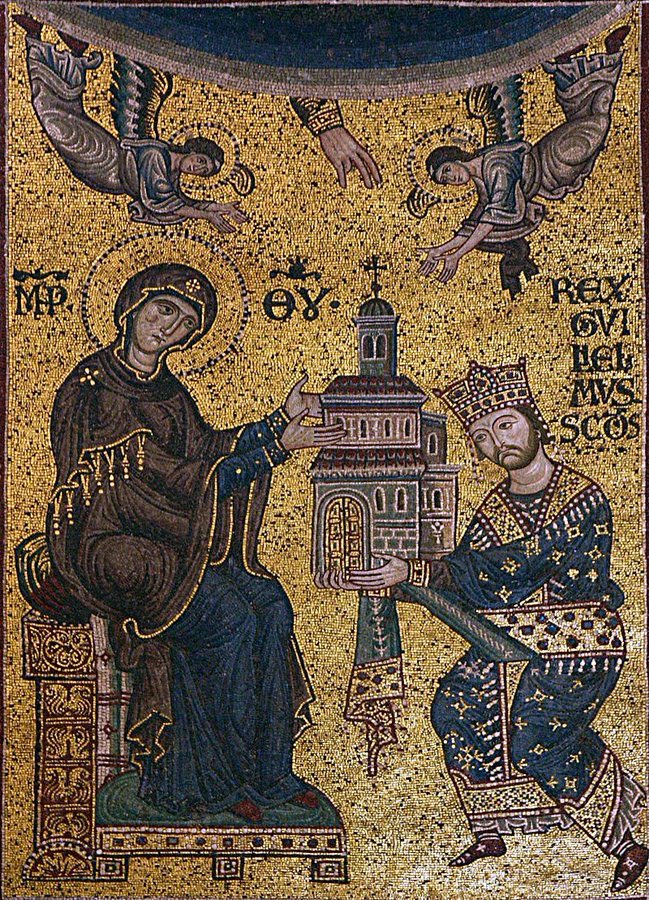
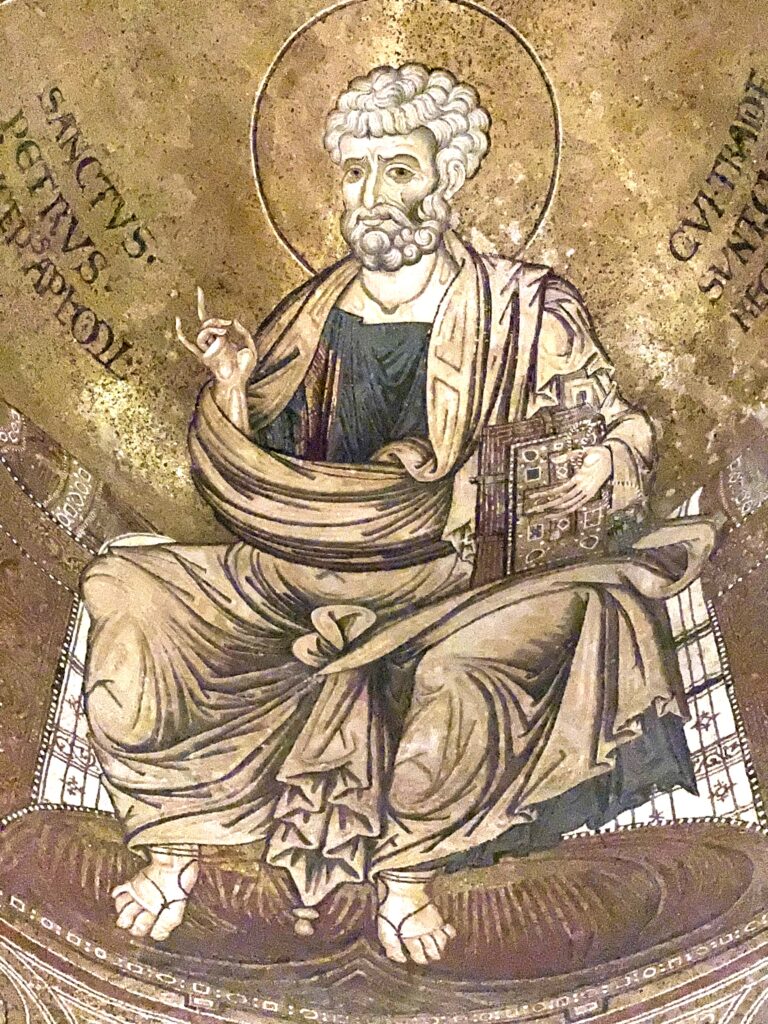
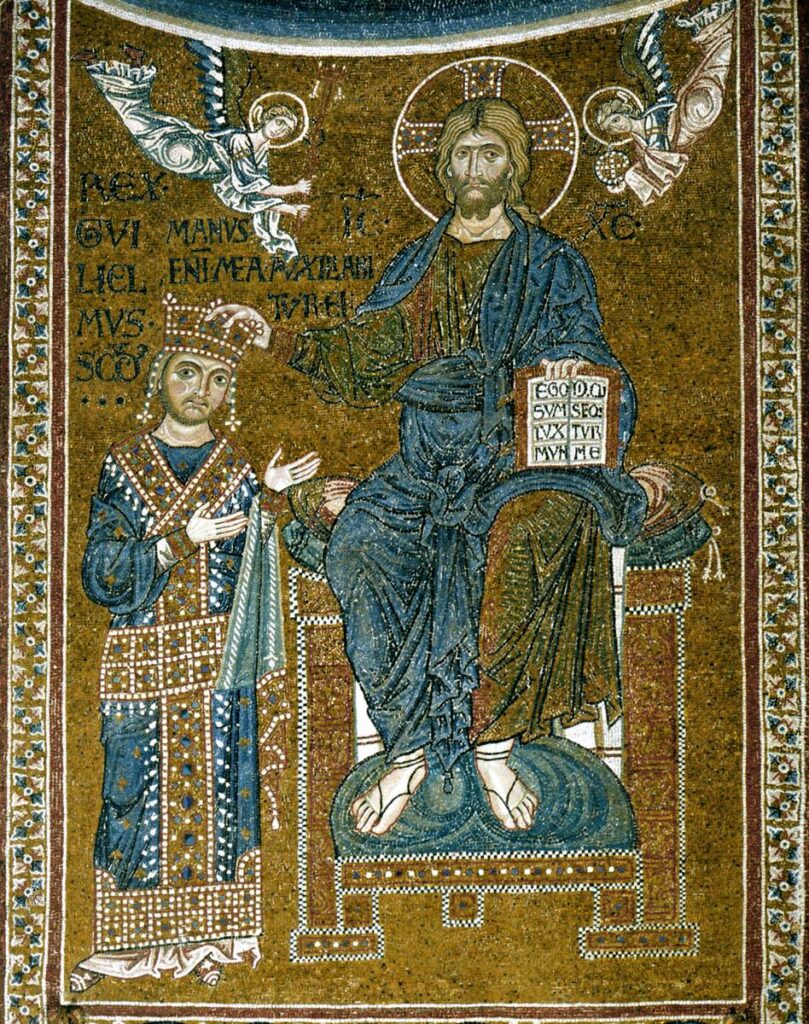
Below him are images of the Virgin Mary enthroned with child and a row of saints. The side apses have scenes from the lives of Saint Peter and Paul.
Naturally, there’s a large mosaic of the king, the Coronation Mosaic. Wearing a Byzantine ceremonial stole, he stands triumphant while being crowned by Christ. By wearing those robes, William was trying to equate his rule with the wealth and power of the Byzantine Empire.
In another important panel, William is kneeling before the Virgin Mary presenting her an architectural gift of the cathedral. In doing so, he intentionally bypasses the Bishop of Palermo.
You’ll also see a grumpy looking Adam and Eve, Noah’s ark perched on a wave, a last supper, and Christ healing a leper.
Like many church decorations, the mosaics were intended to tell bible stories. that would educate the populace.
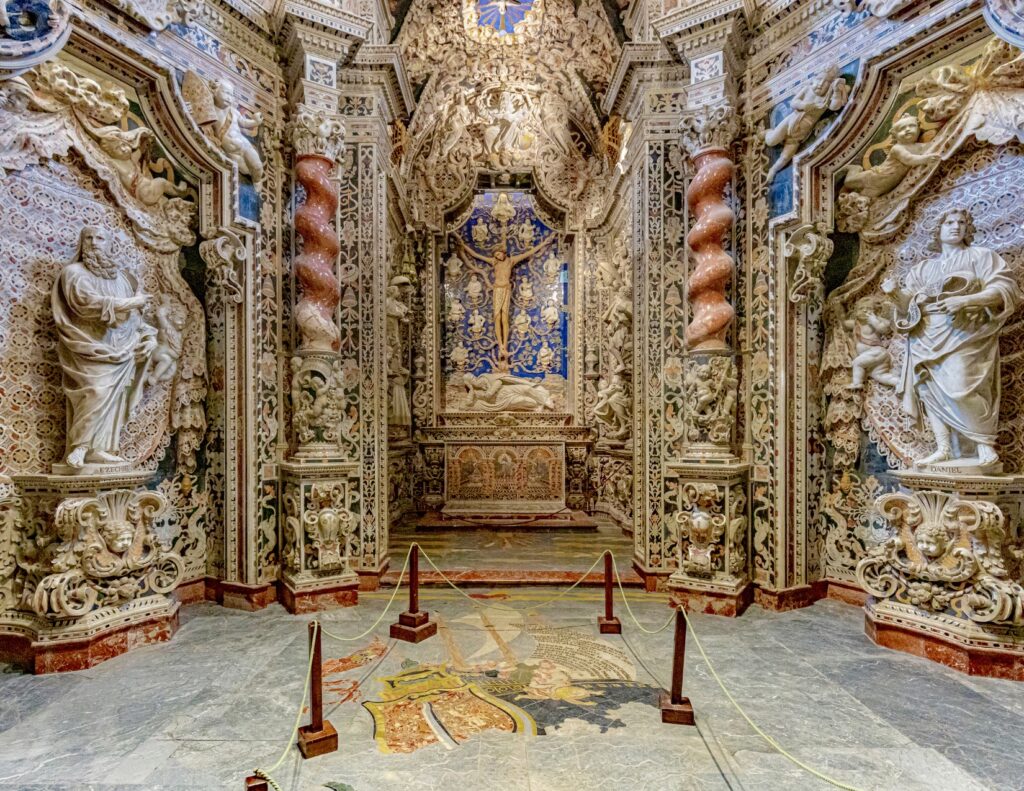
Chapel of the Crucifix
At the left side of the sanctuary is the 17th century Chapel of the Crucifix. It was built by the powerful Spanish archbishop Giovanni Roano.
It’s quite frothy, decorated in the Sicilian Baroque style that was more dramatic and theatrical than that found on mainland Italy. In the center is a 15th century wooden statue of Christ.
He’s flanked by twisty red marble columns. All the decorative motifs are related to Christ’s ultimate sacrifice. The four statues are of the prophets Daniel, Isaiah, Jeremiah, and Ezechiel.
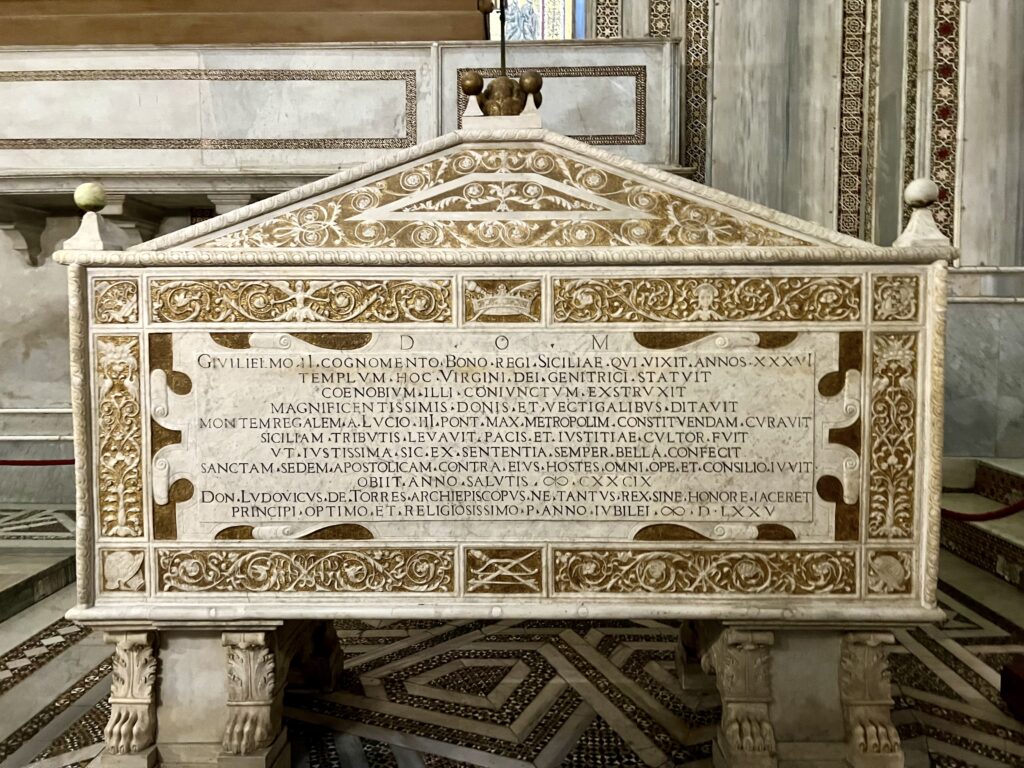
Even the colors are majestic. Red represents Christ’s passion. The lapis lazuli blue represents the sky and divine revelation.
You can also see the cathedral treasury with reliquaries, vestments, and other ecclesiastic art.
Tombs
In the right sanctuary, you’ll find the tombs of William I (the “bad king”) and William II (the “good king”). In the left wing, are the tombs of Margaret of Navarre, the wife of William I, and their sons Roger and Henry.
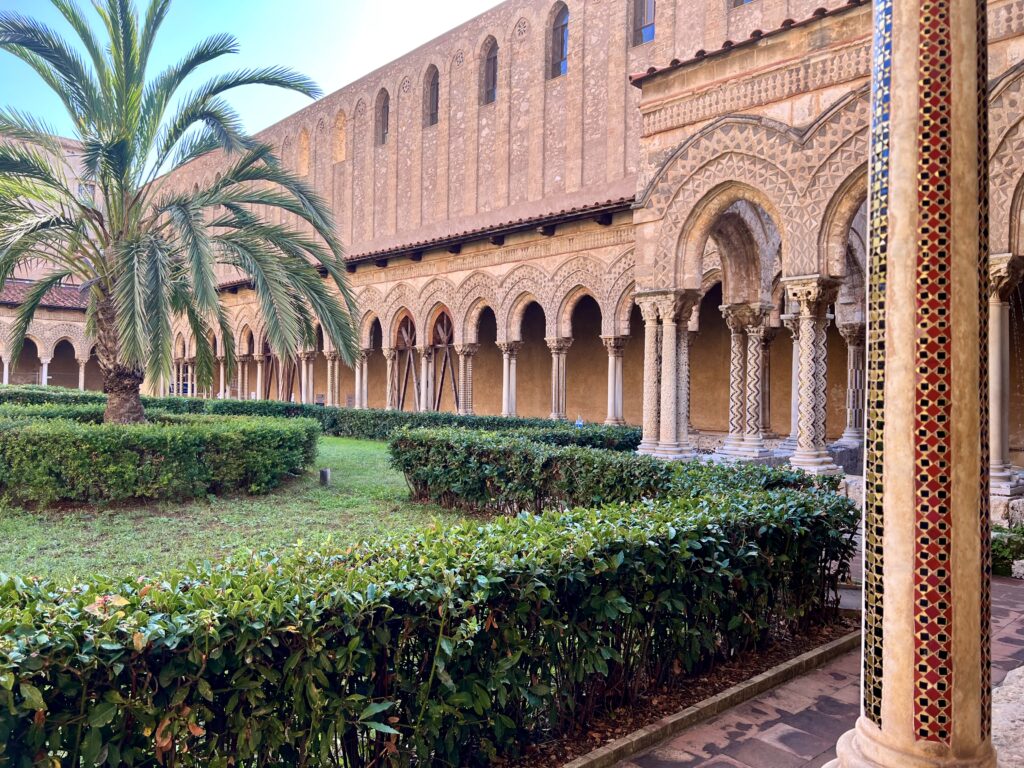
Cloisters
The cloisters are all that is left of the medieval monastery. But they are extraordinarily beautiful and the best preserved one of its type in Sicily.
In medieval times, the cloister was the center of monastic life. It’s a peaceful space imbued with spirituality that seems like an alternate world.
Though cloisters are associated with Western monasticism, this one reflects the influence of other cultures. It’s more of an Arabesque fantasy.
There are 26 pointy Moorish arches in a colonnade on each of the four sides. They open on to a luxuriant garden. There are no flowers. Instead, you’ll find symbolically planted figs, pomegranates, olive bushes, and palm trees from the bible.
The arches are supported by 228 double columns with 100 ornate capitals. The columns are made of Carrera marble and inlaid with abstract geometric mosaics. No two are alike.
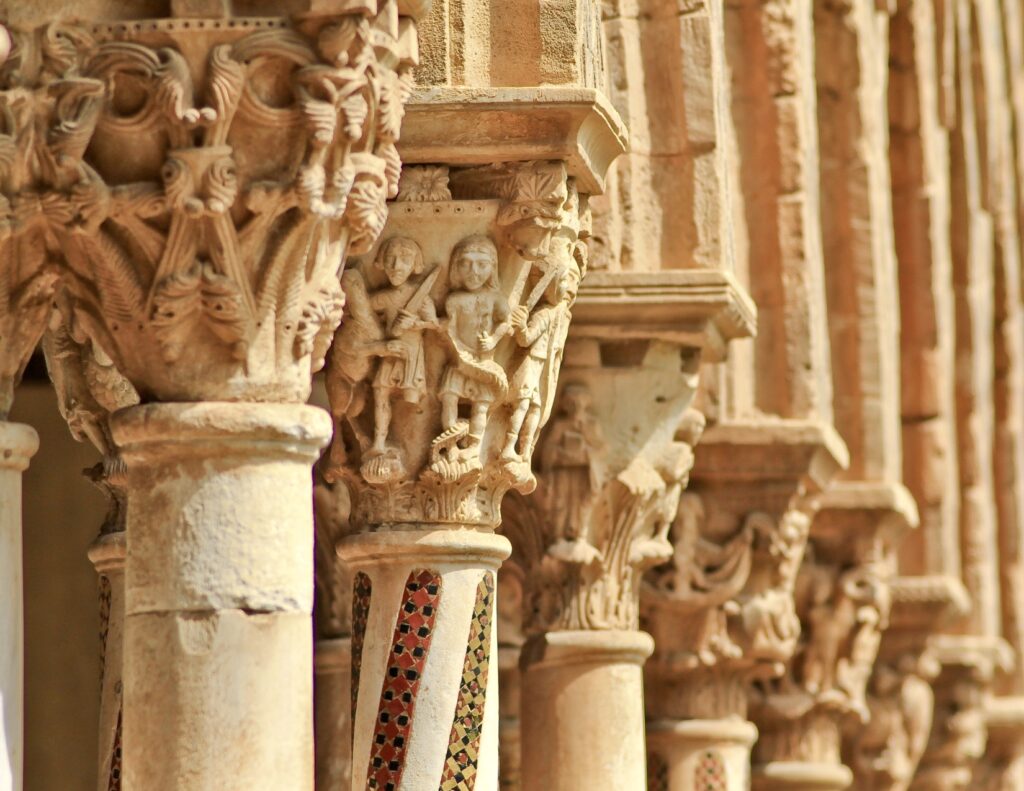
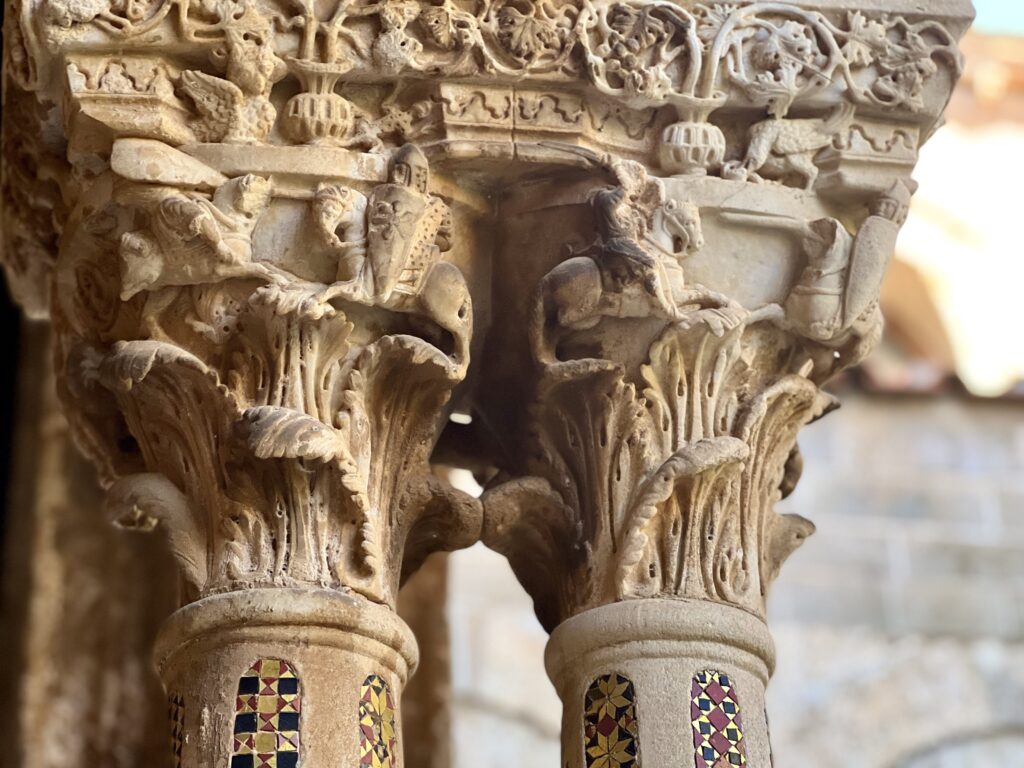
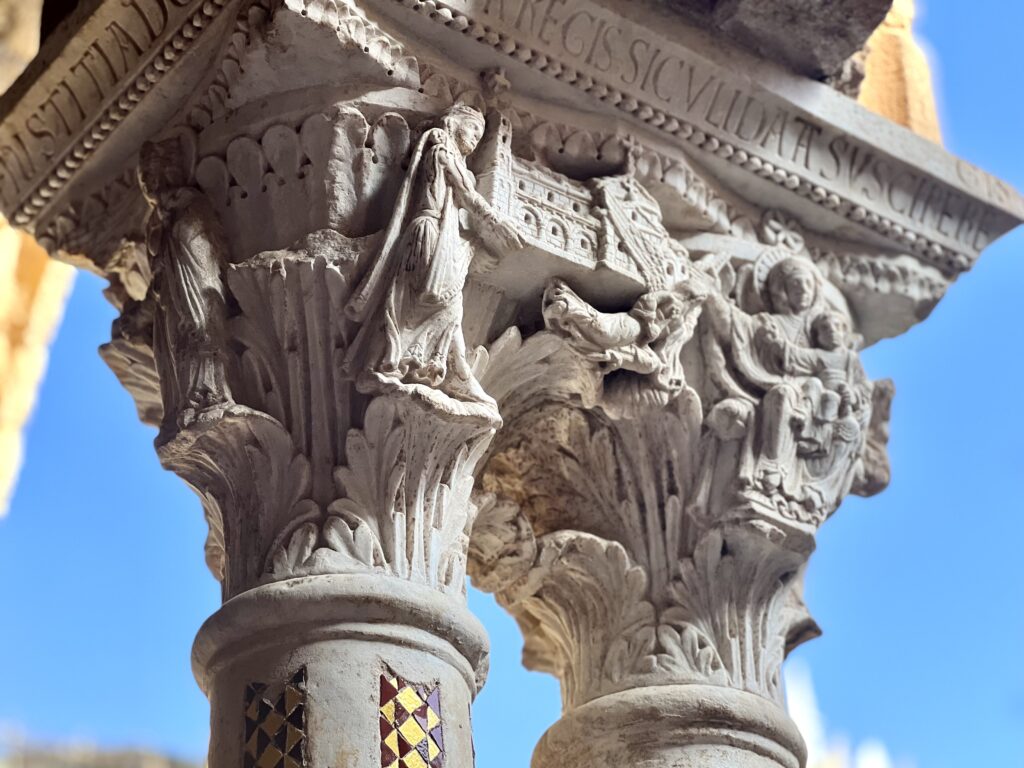
The capitals were created by several different artists and have every imaginable design.
They are very elaborately carved, with mythical creatures, pagan goddesses (baptized by a cross on their heads), floral decorations, Norman knights, Arab warriors, and biblical scenes.
They depict famous scenes, including a Norman jousting event, the massacre of the innocents, William II wearing a Byzantine crown, the nativity, and a lovemaking scene.
The most famous scene is William presenting a model of the duomo to Mary (the 19th capital on the west side).
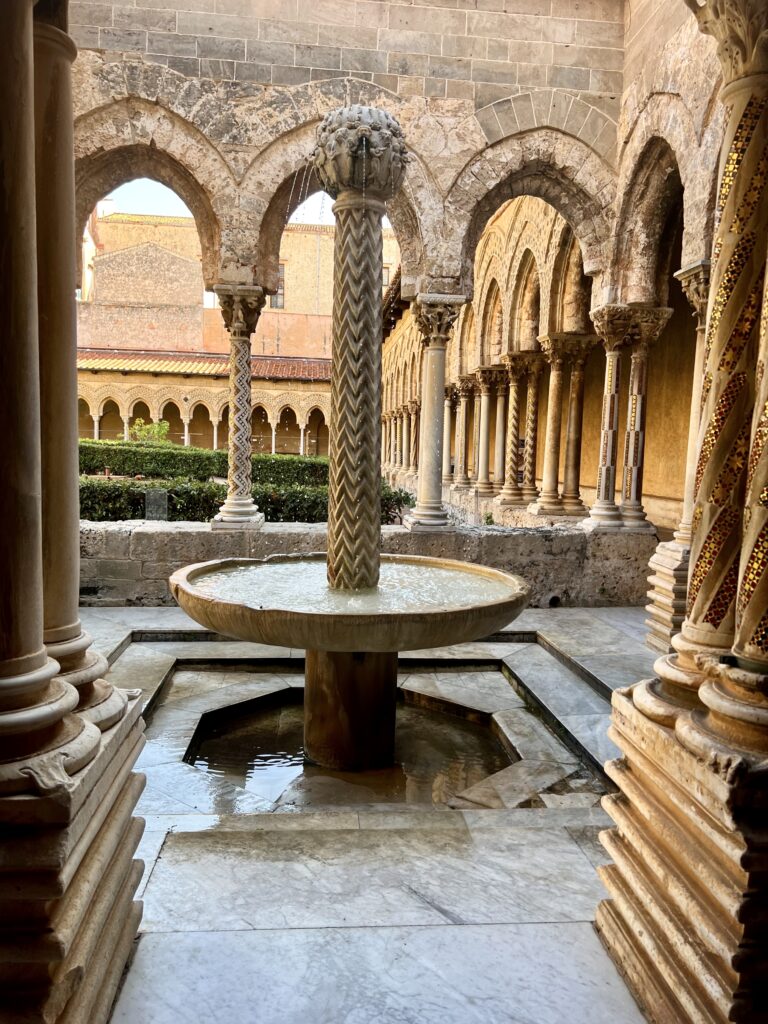
The cloister comes complete with a fountain that looks straight out of Granada’s Alhambra, with a stylized palm tree trunk. It adds a touch of romance to the place.
Water is a fundamental element of a cloistered space, a sign of purification.
Rooftop
You can also hike up to the top of the church from a door in the right aisle. The path is a bit cramped and narrow.
But once you arrive at the top, there’s a narrow circular terrace offering great views of the cloister, the town, Palermo, and the Golden Valley.
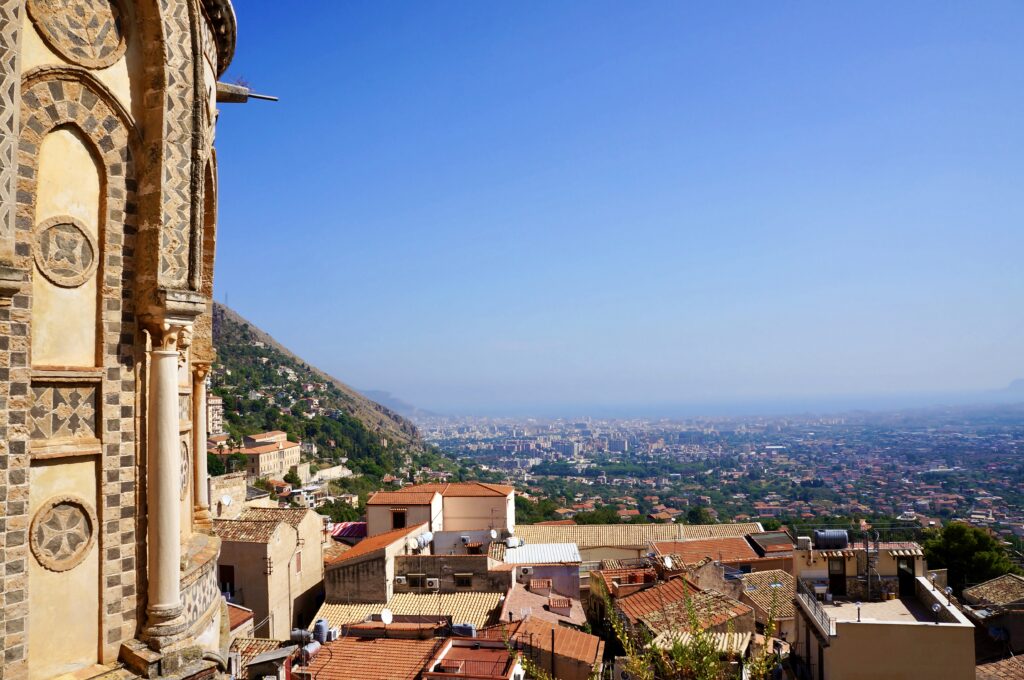
Tips For Visiting Monreale Cathedral
1. How To Get To Monreale Cathedral
If you have a car, you can drive to the cathedral. It’s approximately 30 minutes southwest of Palermo.
You’ll need to throw your car in the municipal parking lot at Via Ignazi Florio. Or, look for the limited street parking. To get the full scoop on Monreale Cathedral, you can book a guided tour from an expert in advance.
I honestly don’t advise driving, though, unless you have nerves of steel. The traffic in Monreale seemed even worse than Palermo to me. There are other means of transport.
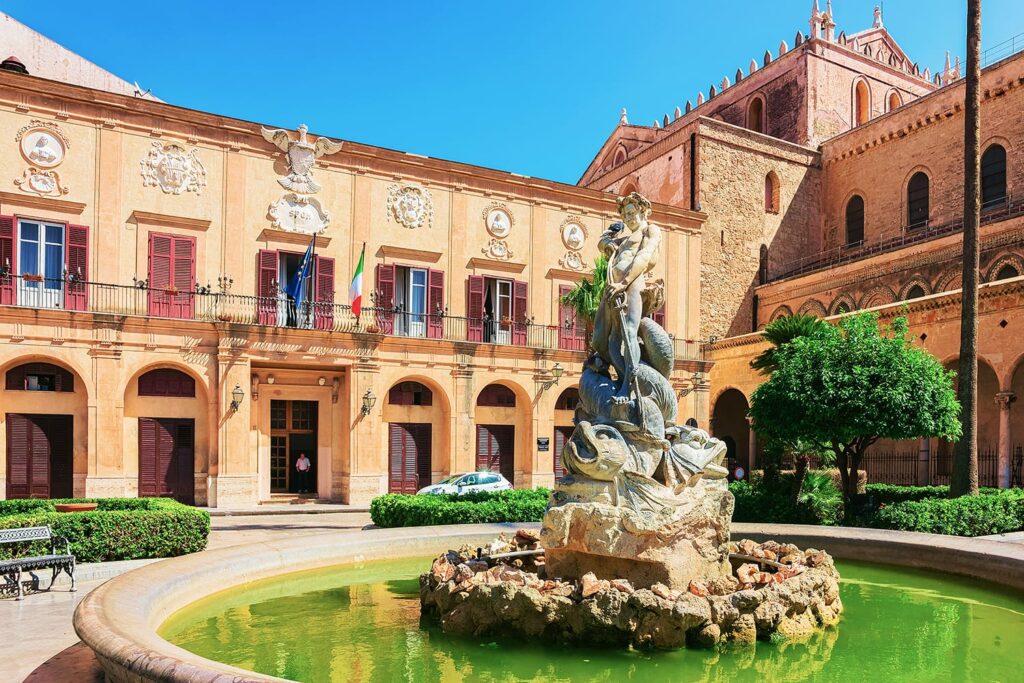
You can take the bus to Monreale from either Piazza dei Norman (opposite the Norman Palace) or Piazza Indipendenza. You could also take a taxi or ride the Palermo hop on hop off bus.
The best and easiest way to visit the cathedral is by a guided tour. Taking a tour will be efficient and save your some headaches.
You can book a half day guided tour from Palermo or, even better, a private tour that incudes the Capuchin Catacombs in Palermo. You can also combine the cathedral with a visit to the pretty town of Cefalu.
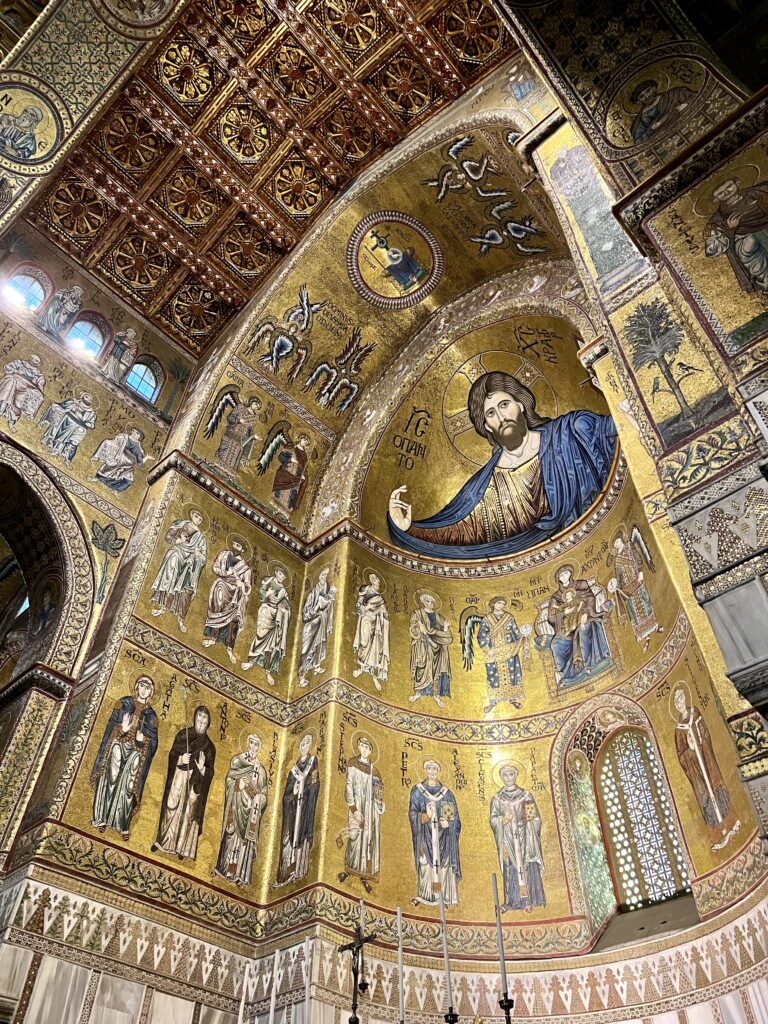
2. Entry Fees
Access to the cathedral itself is free. Entry to the cloisters is 6 euros. Click here to book a cloisters ticket.
There’s also a combined ticket that gives you entry to the Roano Chapel, the cloisters, roof terraces, and the Diocesan Museum for 12 euros. I think it’s totally worth it to buy the full ticket.
The museum is in the Archbishop’s Palace. I didn’t visit so can’t comment on whether it’s worthwhile.
3. Opening Hours
Opening times may vary seasonally and frequently change. So you should check the website when planning a visit. In the winter, the cathedral closes between noon and 4:00 pm, reopening from 4:00 pm to 6:00 pm.
You cannot visit during mass.
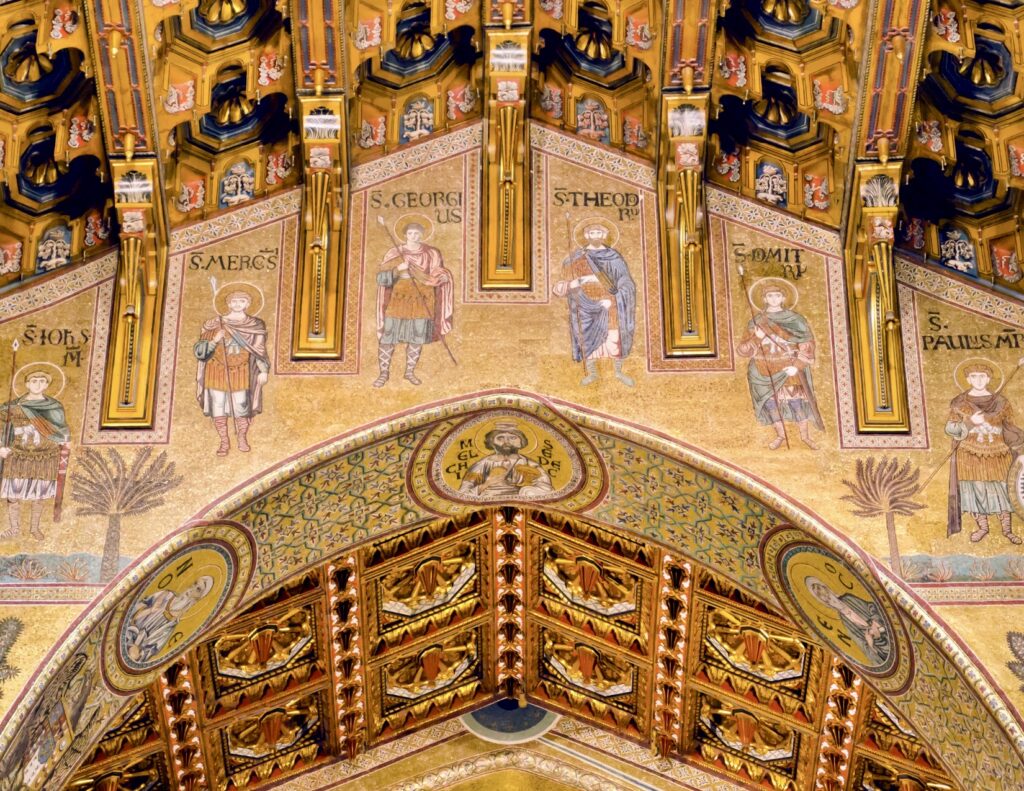
4. Dress Code
The cathedral has a strict dress code. Women must cover their shoulders and should not wear shorts unless they’re down to your knees. Men cannot wear hats.
5. Is Monreale Cathedral Worth Visiting?
100% yes! Monreale Cathedral is one of the architectural marvels of the Middle Ages. There’s a saying in Palermo: “He who visits Palermo without visiting Monreale arrives as a donkey and leaves an ass.”
6. Monreale Cathedral vs. Palermo Cathedral
If you are trying to decide which cathedral to visit, I definitely think you should choose Monreale.
Palermo Cathedral is spectacular from the outside. But, unlike Monreale, the cathedral interior is plain and mostly Neo-Classical in style. The main reason to go inside Palermo Cathedral is to climb up to its roof for the panoramic views.
I hope you’ve enjoyed my guide to Monreale Cathedral. You may enjoy these other Sicily travel guides and resources:
- 2 days in Palermo itinerary
- 2 days in Syracuse itinerary
- 2 days in Trapani itinerary
- 1 day in Catania itinerary
- 1 day in Taormina itinerary
- Guide to the Valley of the Temples
- Guide to Villa Romana del Casale
- Guide to Palermo Cathedral
- Guide To Palermo’s Norman Palace and Palatine Chapel
If you need a guide to Monreale Cathedral, pin it for later.
